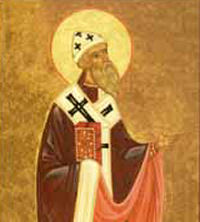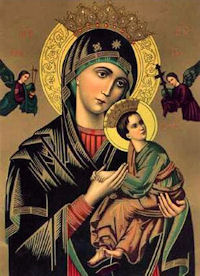
Daily Readings for: June 27, 2012
(Readings on USCCB website)
Collect: O God, who made the Bishop Saint Cyril of Alexandria and invincible champion of the divine motherhood of the most Blessed Virgin Marty, grant, we pray, that we, who believe she is truly the Mother of God, may be saved through the Incarnation of Christ your Son. Who lives and reigns with you in the unity of the Holy Spirit, one God, for ever and ever. Amen.
Ordinary Time: June 27th
Optional Memorial of St. Cyril of Alexandria, bishop and doctor
Old Calendar: Our Lady of Perpetual Help (Hist)
St. Cyril, Patriarch of Alexandria, one of the metropolitan sees of the Christian Church in the east, was one of the great defenders of the faith against the heresy of Nestorius who denied the oneness of person in Jesus Christ. At the Council of Ephesus in 431, over which he presided in the Pope's name, and at his instigation, it was defined that Christ, the Son of God, is at the same time God and man, and the Blessed Virgin Mary, His mother, is truly the Mother of God. St. Cyril died in 444. The Church venerates him as one of her great doctors. His commentary on the Gospel of St. John is one of the richest doctrinally of those left us by the Fathers of the Church.
According to the 1962 Missal of Bl. John XXIII the Extraordinary Form of the Roman Rite, the feast of St. Cyril of Alexandria is celebrated on February 9.
St. Cyril of Alexandria
St. Cyril is one of the great Greek fathers of the Church. He was chosen by divine Providence to be the shield and champion of the Church against Nestorius, who denied the unity of person in Christ. If this heresy had succeeded, Mary would not be called the Mother of God.
Excepting Sts. Athanasius and Augustine, his equal as a defender of orthodoxy, can hardly be found in the Church's history. His greatest achievement was the successful direction of the ecumenical council at Ephesus (431), of which he was the soul (Pope Celestine had appointed him papal legate). In this council two important dogmas were defined – that there is but one person in Christ, and that Mary (in the literal sense of the word) can be called the Mother of God (Theotokos). His successful defense of the latter doctrine is his greatest title to honor.
His writings show such depth and clarity that the Greeks called him the "seal of the fathers." He died in 444 A.D., after having been bishop for thirty-two years. In Rome, the basilica of St. Mary Major stands as a most venerable monument to the honor paid Mary at the Council of Ephesus. On the arch leading into the sanctuary important incidents in the lives of Jesus and Mary are depicted in mosaic.
Excerpted from The Church's Year of Grace, Pius Parsch
In 1881, he was declared a Doctor of the Church by Pope Leo XIII, and in 1944, on the fifteenth centenary of Cyril's death, Pope Pius XII issued his encyclical Orientalis Ecclesiae, commemorating Cyril's place in the history of the Church.
Excerpted from The One Year Book of Saints by Rev. Clifford Stevens
Patron: Alexandria; Egypt.
Symbols: Shown holding a pen; with the Blessed Virgin Mary holding the Child Jesus.
Things to Do:
- Read Pope Pius XII encyclical, Orientalis Ecclesiae (On St. Cyril, Patriarch Of Alexandria).
- Read some excerpts from the writings of St. Cyril at the Crossroads Initiative.
- St. Cyril lived in the fifth century and combated the heresy of Nestorius, who denied the union between the humanity and divinity of Our Lord Jesus Christ, and thus, the divine motherhood of the Blessed Virgin Mary. (See Catechism of the Catholic Church 466) Read what the Catholic Encyclopedia says about Nestorius and Nestorianism.
Our Lady of Perpetual Help Our Lady of Perpetual Help (or of Perpetual Succour) is a Byzantine icon from the late middle ages and has resided in Rome since the late 1400s. The Eastern Catholics call it "Holy Theotokos of the Passion."
Our Lady of Perpetual Help (or of Perpetual Succour) is a Byzantine icon from the late middle ages and has resided in Rome since the late 1400s. The Eastern Catholics call it "Holy Theotokos of the Passion."
The image depicts the Blessed Virgin Mary wearing a blue mantle and veil. On the left side is the Archangel Michael, carrying the lance and sponge of the crucifixion of Jesus. On the right is the Archangel Gabriel carrying the cross and nails. The Christ child rests in her arms and looks intently at the cross.
Tradition states that the icon memorializes an occasion in which the young Christ awoke from a dream in which He saw the instruments of His passion. Mary comforted Him, but remained solemn since she knew that that the dream was a portent of her Son's future passion. The icon brilliantly captures both the reality of the incarnation and the reality of the crucifixion of Christ in one single image that mystically links the events to Mary - who was present for each.
The icon was brought to Rome by a pious merchant, who desired that the picture should be exposed in a church for public veneration. It was exposed in the church of San Matteo, Via Merulana, between St. Mary Major and St. John Lateran.
The rascally French invaded Rome in 1812 and destroyed the church - and the icon disappeared.
In 1865, the icon was rediscovered to the joy of many. Pope Pius IX as a boy had prayed before the icon in the church of San Matteo before it was lost during the French invasion. Pius IX took great interest when the icon was finally rediscovered - since he had been especially devoted to it. He subsequently approved a liturgical feast in commemoration of the icon. The Redemptorists especially revered the image for its profound spiritual meaning.
Today it is one of the most popular images of Our Lady and it is one of the few images that is universally revered in every rite of the Catholic Church - East to West.
Excerpted from Canterbury Tales
Things to Do:
- Visit the Redemptorists' site and read the History of the Icon.
- Make virtual pilgrimage to Our Lady of Perpetual Help Shrine.
- Visit Our Lady of Perpetual Help Radio site to see an explanation of the symbols of the Icon.
- See also Women for Faith & Family page on Our Lady of Perpetual Help.